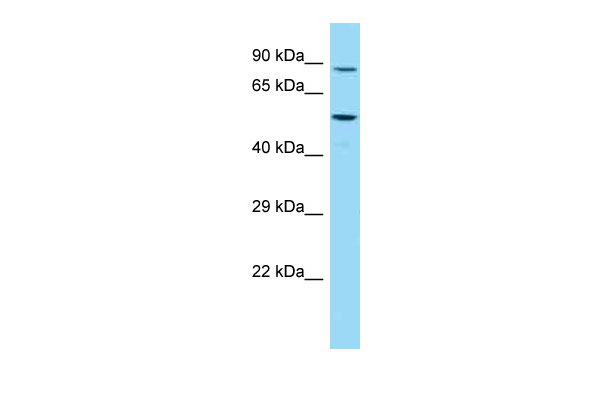CD6 antibody - C-terminal region
Rabbit Polyclonal Antibody
- SPECIFICATION
- CITATIONS
- PROTOCOLS
- BACKGROUND

Application
| WB |
|---|---|
| Primary Accession | P30203 |
| Other Accession | NM_006725, NP_006716 |
| Reactivity | Human, Rat, Rabbit, Bovine, Dog |
| Predicted | Human, Rabbit, Bovine, Dog |
| Host | Rabbit |
| Clonality | Polyclonal |
| Calculated MW | 73kDa |
| Gene ID | 923 |
|---|---|
| Alias Symbol | FLJ44171, TP120 |
| Other Names | T-cell differentiation antigen CD6, T12, TP120, CD6, CD6 |
| Format | Liquid. Purified antibody supplied in 1x PBS buffer with 0.09% (w/v) sodium azide and 2% sucrose. |
| Reconstitution & Storage | Add 50 ul of distilled water. Final anti-CD6 antibody concentration is 1 mg/ml in PBS buffer with 2% sucrose. For longer periods of storage, store at 20°C. Avoid repeat freeze-thaw cycles. |
| Precautions | CD6 antibody - C-terminal region is for research use only and not for use in diagnostic or therapeutic procedures. |
| Name | CD6 (HGNC:1691) |
|---|---|
| Function | Cell adhesion molecule that mediates cell-cell contacts and regulates T-cell responses via its interaction with ALCAM/CD166 (PubMed:15048703, PubMed:15294938, PubMed:16352806, PubMed:16914752, PubMed:24584089, PubMed:24945728). Contributes to signaling cascades triggered by activation of the TCR/CD3 complex (PubMed:24584089). Functions as a costimulatory molecule; promotes T-cell activation and proliferation (PubMed:15294938, PubMed:16352806, PubMed:16914752). Contributes to the formation and maturation of the immunological synapse (PubMed:15294938, PubMed:16352806). Functions as a calcium- dependent pattern receptor that binds and aggregates both Gram-positive and Gram-negative bacteria. Binds both lipopolysaccharide (LPS) from Gram-negative bacteria and lipoteichoic acid from Gram-positive bacteria (PubMed:17601777). LPS binding leads to the activation of signaling cascades and down-stream MAP kinases (PubMed:17601777). Mediates activation of the inflammatory response and the secretion of pro-inflammatory cytokines in response to LPS (PubMed:17601777). |
| Cellular Location | Cell membrane; Single-pass type I membrane protein. Note=Detected at the immunological synapse, i.e, at the contact zone between antigen-presenting dendritic cells and T-cells (PubMed:15294938, PubMed:16352806). Colocalizes with the TCR/CD3 complex at the immunological synapse (PubMed:15294938) |
| Tissue Location | Detected on thymocytes (PubMed:15294938). Detected on peripheral blood T-cells (PubMed:15048703, PubMed:16352806) Detected on natural killer (NK) cells (PubMed:16352806). Soluble CD6 is detected in blood serum (at protein level) (PubMed:17601777). Detected in spleen, thymus, appendix, lymph node and peripheral blood leukocytes (PubMed:9013954). Expressed by thymocytes, mature T-cells, a subset of B-cells known as B-1 cells, and by some cells in the brain |

Thousands of laboratories across the world have published research that depended on the performance of antibodies from Abcepta to advance their research. Check out links to articles that cite our products in major peer-reviewed journals, organized by research category.
info@abcepta.com, and receive a free "I Love Antibodies" mug.
Provided below are standard protocols that you may find useful for product applications.
References
Bowen M.A.,et al.J. Immunol. 158:1149-1156(1997).
Taylor T.D.,et al.Nature 440:497-500(2006).
Aruffo A.,et al.J. Exp. Med. 174:949-952(1991).
Castro M.A.,et al.J. Immunol. 178:4351-4361(2007).
Swack J.A.,et al.J. Biol. Chem. 266:7137-7143(1991).
If you have used an Abcepta product and would like to share how it has performed, please click on the "Submit Review" button and provide the requested information. Our staff will examine and post your review and contact you if needed.
If you have any additional inquiries please email technical services at tech@abcepta.com.













 Foundational characteristics of cancer include proliferation, angiogenesis, migration, evasion of apoptosis, and cellular immortality. Find key markers for these cellular processes and antibodies to detect them.
Foundational characteristics of cancer include proliferation, angiogenesis, migration, evasion of apoptosis, and cellular immortality. Find key markers for these cellular processes and antibodies to detect them. The SUMOplot™ Analysis Program predicts and scores sumoylation sites in your protein. SUMOylation is a post-translational modification involved in various cellular processes, such as nuclear-cytosolic transport, transcriptional regulation, apoptosis, protein stability, response to stress, and progression through the cell cycle.
The SUMOplot™ Analysis Program predicts and scores sumoylation sites in your protein. SUMOylation is a post-translational modification involved in various cellular processes, such as nuclear-cytosolic transport, transcriptional regulation, apoptosis, protein stability, response to stress, and progression through the cell cycle. The Autophagy Receptor Motif Plotter predicts and scores autophagy receptor binding sites in your protein. Identifying proteins connected to this pathway is critical to understanding the role of autophagy in physiological as well as pathological processes such as development, differentiation, neurodegenerative diseases, stress, infection, and cancer.
The Autophagy Receptor Motif Plotter predicts and scores autophagy receptor binding sites in your protein. Identifying proteins connected to this pathway is critical to understanding the role of autophagy in physiological as well as pathological processes such as development, differentiation, neurodegenerative diseases, stress, infection, and cancer.


